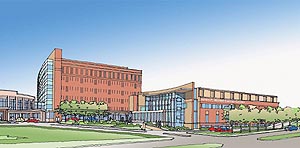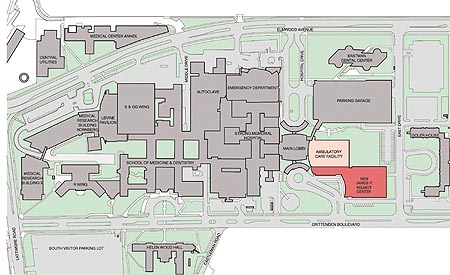

Cancer Center
Searching for Cures
Spring groundbreaking for new building punctuates Wilmot Cancer Center’s drive to national prominence.
 |
| CENTER SPACE: The new building will consolidate the center’s programs into one location. |
One of the University’s newest buildings will offer state-of-the-art resources to physicians, researchers, and patients in combating one of medical science’s longstanding foes: cancer.
In May, the James P. Wilmot Cancer Center plans to break ground on a new 163,000-square-foot, four-story building designed to improve patient care, double the center’s research space, and consolidate cancer programs in one site at the Medical Center.
The building is part of a five-year, $65 million strategic plan to recapture Rochester’s designation as a comprehensive center from the National Cancer Institute.
“Our vision is clear: We will take a leadership role in finding cures for cancer,” says Richard I. Fisher, an internationally recognized lymphoma specialist and director of the Wilmot Cancer Center.
Scheduled to be completed in 2008, the new building is the latest chapter in the center’s 25-year history. With a focus on some of the most common and deadly cancers—lymphoma and leukemia, and breast, prostate, lung, and colon cancers—the center has earned a reputation as a leading cancer center since it was built in 1979.
Under the new plan, the center aims to recruit 25 new specialists and to increase funding for research by as much as 50 percent. In 2004, the center received about $71 million in National Institutes of Health and National Cancer Institute research grants.
The plan includes a comprehensive campaign to raise $42.5 million that’s being led by campaign cochairs Judy Wilmot Linehan of Mendon, New York, and James Ryan Jr. of Brighton.
Already a critical resource for upstate New York, the center’s oncologists and staff care for about 6,500 people each year, performing 13,000 chemotherapy infusions and 19,000 radiation treatments.
The building is being designed to reflect the staff’s consistently high-quality patient care.
 |
| TRANSLATIONAL: Bringing cancer programs together at the Medical Center is designed to spur interaction between scientists to discuss research and treatment options. |
“When you’re diagnosed with cancer, the choices you make regarding diagnosis, treatment, and ongoing care are critically important,” says Fisher. “You need to find the team with the highest degree of knowledge, experience, and compassion in treating your specific disease. With this new plan, we affirm our commitment to making Rochester the very best choice.”
The new building and programs will allow people from the region to stay close to home and will accommodate a growing number of people from outside Rochester. The center has one of the largest clinical programs for lymphoma and leukemia in the Northeast and leads the nation in shaped-beam stereotactic radiosurgery to destroy tumors.
“Patients once considered untreatable are now being cured,” says Paul Okunieff, chair of the Department of Radiation Oncology.
In addition, translational research laboratories—designed to bring discoveries from research labs to patients’ bedsides—will be moved into the center, allowing scientists and oncologists to talk about ideas, research, and treatment outcomes. That model has proven effective in the nation’s elite cancer centers.
“In recent history, many cancer breakthroughs are a result of scientists and doctors working together toward better treatments,” says Fisher. “We’re creating an environment that will foster greater ideas through cooperative research.”
Capturing the National Cancer Institute designation as one of the top cancer centers in the nation is more than symbolic, say Wilmot and Medical Center leaders.
“When you build clinical and research programs that demonstrate leadership within the cancer field, the National Cancer Institute recognizes those contributions by funding additional research and designating the center as one of the best in the country,” says Fisher, who worked at the institute from 1972 to 1984.
The expansion project also is expected to double the center’s economic impact on the Finger Lakes region. A report from the Center for Governmental Research estimates the total number of jobs at the center would increase to 1,200, with 700 additional positions indirectly supporting the operation. That would increase the center’s impact on regional payroll to $71 million. And, in the short-term, the construction phase would create 750 jobs.
One feature of the new building will be the opportunity to continue expanding clinical studies, in which eligible patients have the advantage of the very latest therapies. Currently, more than 800 patients are enrolled in 130 clinical trials.
Michael Donnelly, a Rochester communications and fundraising professional, recalls the day in 2003 when his oncologist suggested a clinical trial following surgery to treat pancreatic cancer, a condition with a very high mortality rate.
“I asked how many others were enrolled in this protocol and was told that I was the first here and one of only a handful around the country,” he says. “I was fortunate to have access to this care in Rochester.”
The strategic plan and the collaborative research atmosphere fostered by the new building also will support research that leads to new technologies. The center has pioneered surgical technologies in recent years, notably robotic laparoscopic surgery for prostate cancer.
“The Sunday before my surgery, I asked my church to pray for me and my family,” recalls Alan Caine, the founder and CFO of a Rochester IT services and security firm. “The following Sunday I was back in church—a living testimonial to the short recovery time with this procedure. I was 100 percent cured.”
Wilmot Cancer Center oncologists hope to hear those words even more frequently.
“We believe the cure starts here,” says Fisher.
